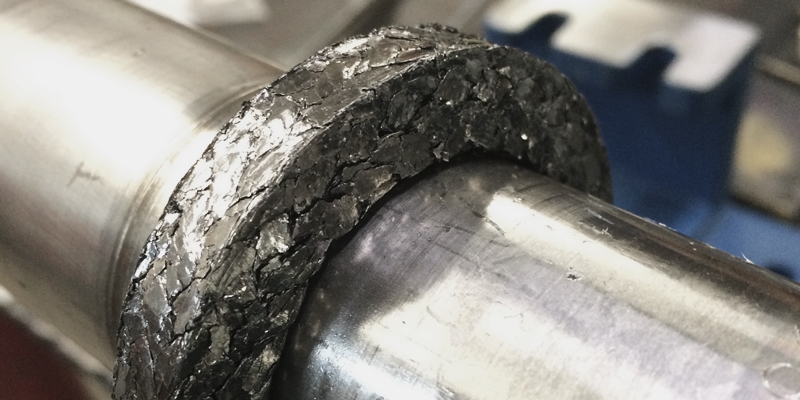
Root cause failure analysis for pump packing is similar to RCFA for mechanical seals. Just using your eyes and this guide, you can identify with confidence why the packing failed. Then, you can determine if a change is necessary and/or cost effective.
Potential changes include:
- Using a different style or material of packing
- Cutting the rings differently
- Buying them pre-cut and pre-formed
- How the packing is installed
- How the packing is “broken in”
- Use of environmental controls like circulation or flushing
Here are the steps to root cause failure analysis for packing.
Keep all the rings of packing in the order they were removed.
Try to determine how long the pump ran before the packing failed.
-
If the packing looks or smells like it was burnt, the packing experienced temperatures higher than the what the packing could handle. This could be a result of:
- The pump running dry
- The packing being installed too tightly
- The process fluid temperature itself
- Wrong choice in packing material
- Combination of these
For example, some packing made from poly-acrylonitrile (PAN) can only handle a few hundred degrees F. Between the process fluid temperature and the additional heat from the friction of the packing, this temperature limit can easily be exceeded. It is important to select the proper packing material that can not only handle the temperature of the process fluid, but also the additional heat from friction.
-
Measure the packing from the inside to the outside and from the front to the back in several places.
The reason you should measure the packing in several places is to confirm if the shaft is centered in the stuffing box. It is not uncommon for the packing to compress a little from the front to the back in service.
If the packing is thin from the inside to the outside, it can mean several things:
- It can be the wrong size packing
- Shaft whip or runout
Double check to make sure you are using the right size packing for your pump. For an STX pump, you will need 5/16" square packing. For an MTX pump, you will need 3/8" packing. In general, you can arrive at the correct packing size by first measuring the diameter of the stuffing box, then subtract the shaft/sleeve diameter, then divide that number by 2. For an STX standard bore:
- standard stuffing box bore diameter: 2.00"
- shaft diameter: 1.375"
- 2.00 - 1.375 = 0.625
- 0.625 / 2 = 0.3125 (5/16")
Examine the first ring of packing, the one closest to the throat of the stuffing box. The throat is the restricted part of the stuffing box at the opposite end from the gland. If the first ring has a feathered area where the packing has thinned out to an almost fabric-like condition, it indicates the throat may have opened up past the .030” on a side typical clearance. An easy fix here would be to provide a split washer to put at the throat of the stuffing box. The outside diameter of this bushing just needs to be a slip fit to the inside diameter of the stuffing box. The inside diameter as mentioned before should be .030” on a side larger than the shaft or sleeve.
Examine the inside of each packing ring. If it very hard, like a glaze, it is evidence that there was too much friction between the packing and the shaft or sleeve. This can be caused by installing the packing too tightly or a combination of tight packing and high operating temperatures. Most, not all, packing needs to weep or drip a very small amount of fluid. This insures that the process fluid or the flush is sufficient to lubricate the packing. While some modern packings such as pure flexible graphite are self-lubricated, most packings have a small amount of break-in surface lubrication plus some internal lubrication. When that is gone, you are left with the fibers of the packing itself. These may not be enough to seal but may be enough to damage the shaft or sleeve they run on. Damage from packing is called scoring.
Examine the packing for torn fibers. Most packing is braided. The most work is done at the corners of the packing. This is why some packings are made of more than one fiber with a particular fiber like PTFE or Kevlar at the corners. If the fibers are torn the cause can be an extremely abrasive process fluid. However, be careful if you are considering switching to a partial or all-Kevlar packing as Kevlar can be extremely harsh on shafts and sleeves.
